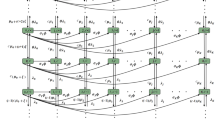Abstract
We consider a queueing system with r non‐identical servers working in parallel, exogenous arrivals into m different job classes, and linear holding costs for each class. Each arrival requires a single service, which may be provided by any of several different servers in our general formulation; the service time distribution depends on both the job class being processed and the server selected. The system manager seeks to minimize holding costs by dynamically scheduling waiting jobs onto available servers. A linear program involving only first‐moment data (average arrival rates and mean service times) is used to define heavy traffic for a system of this form, and also to articulate a condition of overlapping server capabilities which leads to resource pooling in the heavy traffic limit. Assuming that the latter condition holds, we rescale time and state space in standard fashion, then identify a Brownian control problem that is the formal heavy traffic limit of our rescaled scheduling problem. Because of the assumed overlap in server capabilities, the limiting Brownian control problem is effectively one‐dimensional, and it admits a pathwise optimal solution. That is, in the limiting Brownian control problem the multiple servers of our original model merge to form a single pool of service capacity, and there exists a dynamic control policy which minimizes cumulative cost incurred up to any time t with probability one. Interpreted in our original problem context, the Brownian solution suggests the following: virtually all backlogged work should be held in one particular job class, and all servers can and should be productively employed except when the total backlog is small. It is conjectured that such ideal system behavior can be approached using a family of relatively simple scheduling policies related to the cμ rule.
Similar content being viewed by others
References
D. Bertsimas and J.N. Tsitsiklis, Introduction to Linear Optimization (Athena Scientific, Belmont, MA, 1997).
P.B. Chevalier and L.M. Wein, Scheduling networks of queues: Heavy traffic analysis of a multistation closed network, Oper. Res. 41 (1993) 743-758.
D.R. Cox and W.L. Smith, Queues (Methuen, London, 1961).
J.M. Harrison, Brownian Motion and Stochastic Flow Systems (Wiley, New York, 1985).
J.M. Harrison, Brownian models of queueing networks with heterogeneous customer populations, in: Stochastic Differential Systems, Stochastic Control Theory and Applications, eds. W. Fleming and P.L. Lions (Springer, New York, 1988) pp. 147-186.
J.M. Harrison, The BIGSTEP approach to flow management in stochastic processing networks, in: Stochastic Networks: Theory and Applications, eds. F. Kelly, S. Zachary and I. Ziendins (Oxford Univ. Press, Oxford, 1996).
J.M. Harrison, Heavy traffic analysis of a system with parallel servers: Asymptotic optimality of discrete-review policies, Ann. Appl. Probab. 8 (1998) 822-848.
J.M. Harrison, Brownian models of open processing networks: Canonical representation of workload (1997) submitted for publication.
J.M. Harrison and J.A. Van Mieghem, Dynamic control of Brownian networks: State space collapse and equivalent workload formulations, Ann. Appl. Probab. 7 (1997) 747-771.
J.M. Harrison and L.M. Wein, Scheduling networks of queues: Heavy traffic analysis of a simple open network, Queueing Systems 5 (1989) 265-280.
J.M. Harrison and L.M. Wein, Scheduling networks of queues: Heavy traffic analysis of a twostation closed network, Oper. Res. 38 (1990) 1052-1064.
F.P. Kelly and C.N. Laws, Dynamic routing in open queueing networks: Brownian models, cut constraints and resource pooling, Queueing Systems 13 (1993) 47-86.
H.J. Kushner and Y.N. Chen, Optimal control of assignment of jobs to processors under heavy traffic, preprint, Department of Applied Mathematics, Brown University (1998).
H.J. Kushner and P. Dupuis, Numerical Methods for Stochastic Control Problems in Continuous Time (Springer, Berlin/New York, 1992).
H.J. Kushner and L.F. Martins, Routing and singular control for queueing networks in heavy traffic, SIAM J. Control Optim. 28 (1990) 1209-1233.
C.N. Laws, Resource pooling in queueing networks with dynamic routing, Adv. in Appl. Probab. 24 (1992) 699-726.
C.N. Laws and G.M. Louth, Dynamic scheduling of a four-station queueing network, Probab. Engrg. Inform. Sci. 4 (1990) 131-156.
L.M. Wein, Scheduling networks of queues: Heavy traffic analysis of a two-station network with controllable inputs, Oper. Res. 38 (1990) 1065-1078.
L.M. Wein, Brownian networks with discretionary routing, Oper. Res. 39 (1991) 322-340.
L.M. Wein, Scheduling networks of queues: Heavy traffic analysis of a multistation network with controllable inputs, Oper. Res. 40 (1992) S312-S334.
Author information
Authors and Affiliations
Rights and permissions
About this article
Cite this article
Harrison, J.M., López, M.J. Heavy traffic resource pooling in parallel‐server systems. Queueing Systems 33, 339–368 (1999). https://doi.org/10.1023/A:1019188531950
Issue Date:
DOI: https://doi.org/10.1023/A:1019188531950




